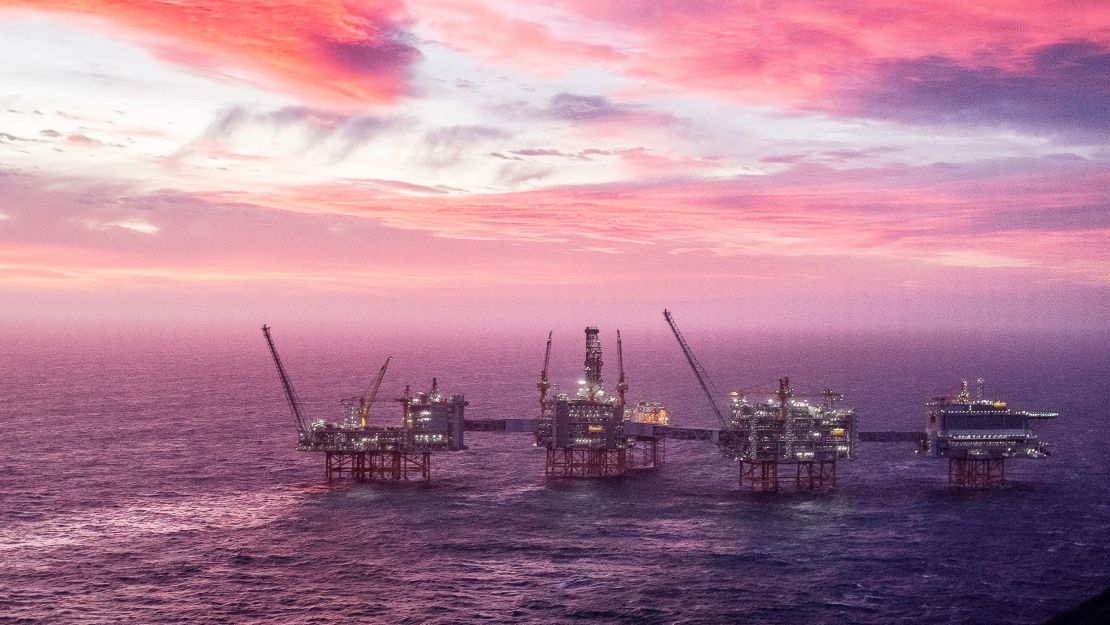It’s not a boast you usually hear about an oil field: Norway says its huge new facility is great for the environment.
The oil-rich nation claims the Johan Sverdrup field, which was opened with pomp by the Prime Minister last week, is helping to “reduce emissions” because it is completely powered by renewable energy.
“Johan Sverdrup is now open. That’s good news for our investors, for Norway – and for emissions,” boasts the official website of Equinor, the Norwegian state company that operates the field.
Its critics, however, see Norway’s third-biggest oil field ever as a perfect symbol of the Scandinavian country’s climate hypocrisy.
The field, located around 87 miles off the Norwegian coast, is named after the country’s first prime minister. It has reserves of 2.7 billion barrels of oil, enough to last half a century and bring more than $100 billion into Norway’s pocket.
The operation is powered by energy brought from the shore, generated mainly from hydroelectric power – a rarity for offshore oil fields, most of which are powered by diesel generators.
It is a fitting example of Norway’s approach to climate change. The country was among the first to ratify the Paris Agreement and has pledged to become climate neutral by 2030. It offers its citizens generous subsidies for electric cars and has banned deforestation.
Yet Norway is also a major fossil fuel producer. It pumps out 2 million barrels of oil a day, according to the International Energy Agency, making it Europe’s second biggest producer after Russia. Its natural gas production also surpasses all other European countries.
“Norway has a schizophrenic relationship with climate and oil and gas,” Lars-Henrik Paarup Michelsen, CEO of the Norwegian Climate Foundation think tank, told CNN. “We are great at adopting ambitious emission targets, but at the same time we plan for oil and gas production for decades to come.”

On top of its significant fossil fuel reserves, Norway also has abundant renewable energy resources, particularly in hydropower. It covers its domestic needs with clean energy and sells most of its oil and gas abroad.
Equinor, the Norwegian state company that operates the Johan Sverdrup field, is working hard to highlight the field’s efficiency. “Average CO2 emissions from international fields are 25 times higher, (with) 18 kg CO2 emitted per barrel produced versus 0.67 kg CO2 emitted per barrel produced from Sverdrup,” Equinor spokesman Morten Eek told CNN.
But Paarup Michelsen said this saving is not significant when considering the bigger picture, because emissions from production account for only 5% of total emissions from the global oil industry.
“The big problem is the combustion, in sectors like transport and industry,” he said.
As Mark van Baal, founder of climate pressure group Follow This, put it: “An oil company with targets for its own emissions, and not for its products is like a cigarette producer that promises that all employees will quit smoking, while increasing cigarette production.”
Who is responsible?
The Norwegian government can claim it is doing all it can to combat climate change, because current international rules place the responsibility for greenhouse gas emissions on the country where they occur.
For Norway, this means that it is not responsible for the emissions caused by the burning of its oil in other places around the world.
According to figures from Norway’s statistical office, the country’s annual domestic greenhouse gas emissions reached around 53 million tons in 2017. That comes to roughly 10 tons per person, which is roughly in line with the rest of Europe. Emissions in the US stood at 15 tons per person in 2017, according to the International Energy Agency.
The emissions generated by Norway’s exports, however, are of a very different magnitude.
According to the United Nations’ Emission Gap Report, emissions from the oil and gas Norway sold abroad reached roughly 470 million tons in 2017.
When the Norwegian government talks about reducing emissions, it means domestic emissions, not from its exports. But the Paris Agreement on climate is clear. To avoid catastrophic global warming, the world has to dramatically cut all carbon emissions.
Experts say that phasing out fossil fuels is essential if global warming is to stay below a rise of 2 degrees Celsius above pre-industrial levels by the end of the century, the goal set by the Paris agreement.
Norway’s Minister of Climate and Environment Ola Elvestuen acknowledged that his country will need to change its ways in the future.
“The world needs to reduce its use of fossil fuel as fast as possible, and of course this will affect both the Norwegian economy and petroleum sector,” he said in a statement emailed to CNN.
Yet despite its climate commitments, Norway’s government policy is also aimed at luring global oil giants to try to find and recover more oil in its territory. Under current laws, companies can deduct 78% of their exploration costs from their taxable income.
The strategy is working. According to the Norwegian Ministry of Petroleum and Energy, activity in the oil and gas industry is rising rapidly.
In 2019, Norway awarded 83 production licenses, a new record, and started 57 new exploration wells.
The Norwegian government is not making any secret of the fact that it has long-term plans for the oil industry.
The Johan Sverdrup field operation is scheduled to run until 2070 – 20 years after global emissions must be zero, according to a pledge signed by Norway’s government.
Elvestuen said that while the new field might be active for a long time, two-thirds of the resources there are projected to be recovered before 2030. After that, production is expected to decline.
“An expression often used by the largest parties in Norway is that the person who will ‘switch the light off’ on (oil production on) the Norwegian shelf has not yet been born,” said Paarup Michelsen.






















